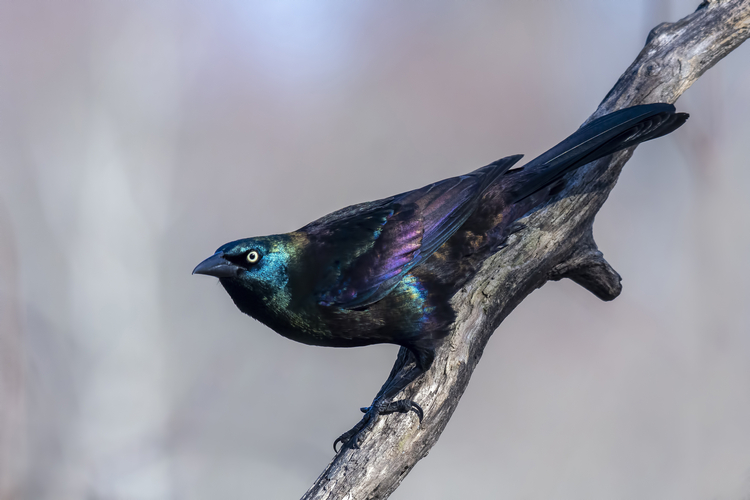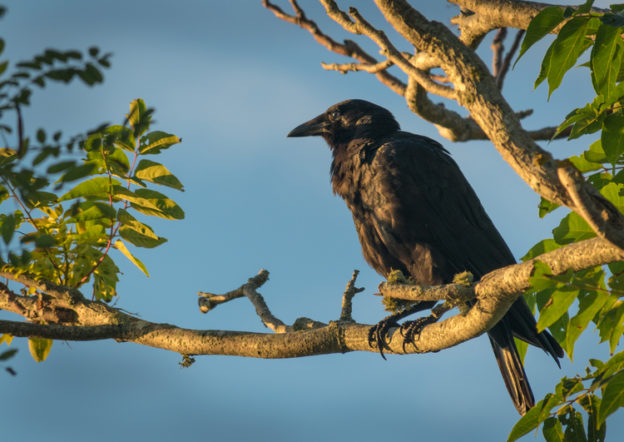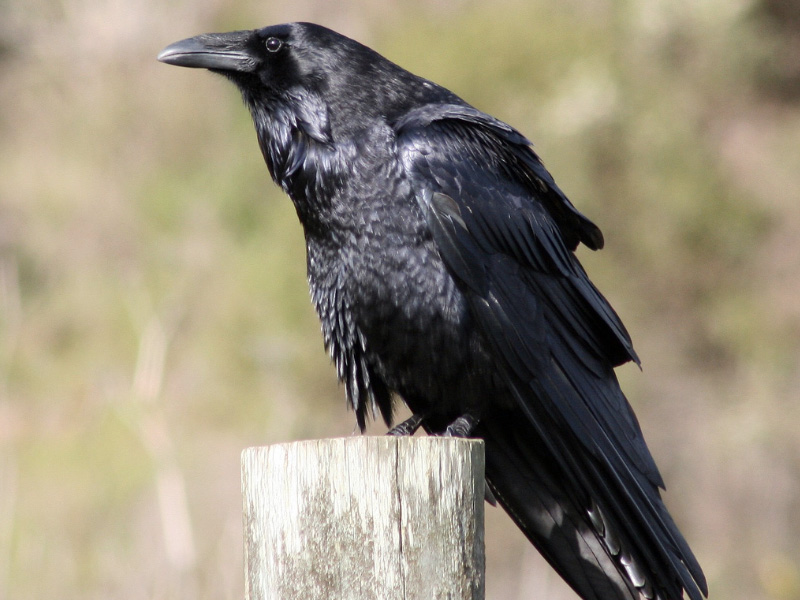Noisy and full of personality, crows, ravens, and grackles are very noticeable. But telling them apart is a different story. So just how can you distinguish a raven from a crow from a grackle? And what makes these birds unique? Read on.
Common Ravens
Ravens, like crows and jays, belong to the family Corvidae. Incredibly intelligent, ravens can even learn to imitate human speech—and some have been taught to say “Nevermore!”
Common Ravens once lived throughout New England, but European settlers saw them as farmers’ pests, lamb-killers and ill omens and did their best to exterminate them. Early colonists also clear-cut forests, which was bad for these birds because they prefer heavy, undisturbed woods. By the 1800s there were few or no ravens in the region. As the forests have regrown and the birds have gained legal protection, ravens have staged a remarkable comeback and are now nesting from the Berkshires to Cape Cod and the Islands.
Tips for identifying common ravens:
- Large size, near that of a Red-tailed Hawk
- Heavy bill
- Shaggy throat when viewed at close range
- Long, slightly pointed wings in flight
- Fairly long wedge-shaped tail
- Frequently seen soaring on flat wings; occasionally tumbles in the air
- Often makes deep, croaking or scratchy, burbling calls
Crows

As with Common Ravens, early colonists also detested and hunted crows, but these smaller, more development-tolerant birds were never completely wiped out in the region. Crows are common throughout Massachusetts, and in late fall and winter they often gather in huge nighttime flocks to roost.
There are two species of crows in Massachusetts: American Crows and Fish Crows. They look nearly identical, though Fish Crows are smaller, have a more buoyant, fast-flapping flight, and make a distinctly nasal call.
Some tips for identifying crows:
- Slimmer beak than raven, with a short tail that is squared off at the end (unlike ravens’ longer, wedge-shaped tails)
- Broader, shorter, and less pointed wings than ravens
- American Crows make a clear-sounding caw that is higher pitched than the deeper croak of a raven
- American Crows are almost as large as a chicken
- Fish Crows make an even higher-pitched, more nasal sounding caw that sometimes sounds like the phrase uh oh!
Common Grackles

Despite also being targeted as pests, Common Grackles managed to prosper after European settlers arrived. Grackles tend to avoid thick, unbroken forests and readily inhabit settled areas. Grackles are members of the blackbird family Icteridae, as are various other Massachusetts birds such as meadowlarks, Bobolinks, and orioles. The Common Grackle is the only grackle species that breeds in Massachusetts.
Tips for identifying common grackles:
- As large as a robin
- Slender body
- Long tails relative to their body size; often appears keel-shaped in flight
- Iridescent blue feathers in a rainbow of colors (especially on the head)
- Striking golden eyes
- Often makes calls that sound like a rusty gate hinge
Learn More About Birds
Interested in honing your bird identification skills? Check out the resources on Birds & Birding on our website. Download backyard bird checklists, sign up for a bird walk with an expert naturalist at one of our wildlife sanctuaries, and learn all about the birds of the Northeast.
updated August 2021




What is being recommended to discourage ravens from landing in an area that they are damaging . The area in question is a lawn bowling green where they are evidently digging for grubs or worms and destroying the green. The green is approx. 120′ square in a park setting. Thank you for your consideration of this question
I’ve seen many ravens out west but never in MA until last week. It was a hazy day and I thought a hawk landed on my neighbor’s roof. Got out my binoculars & saw it was a raven.
Some comments on flying habits would be helpful, for instance, do both crows and ravens call as they fly, and, second, do they maintain family groups? Also, since a group of crows is called a “murder of crows”, does a group of ravens have a similarly-interesting moniker? And, finally, do all three winter over here in New England? Thank you.
It’s called an “unkindness of ravens”!
Ravens are bigger and blacker.
They sure are.
We live in western New England, we have both crows and ravens the ravens are 3times bigger than the crows. You can definitely tell them apart loud also
I live in north central FL and Grackles are very common around here. Beautiful birds with their iridescent feathers.
I’ve just moved, within my city (Cambridge, MA), but from one end to the other. I used to leave sunflower seeds on my 2nd floor balcony and many birds came in the old place, house sparrows, cardinals (a pair and their fledgling), ravens, and blue jays. What I never saw, in 4 years, was a robin, a grackle, or a blackbird, all of which hang out in the trees surrounding my North Cambridge, 3rd floor apartment. The former apartment was not far from the Charles River; the new one is not far from former marshland. What do you think explains the difference in territory?
Usually 8 different types of bird due to my many feeders and specific grain, nuts and berriers. Thanks for info, now know it’s Black Grackels and what I thought were “blackbirds”. My Red tailed Hawks and babbirs are not living due to people putting out RAT poisioning. One good food source for fof Prey is rats, mice etc , STOP!!!@
Hi Sandra Ludwig, I agree with people not using Rat poison. It kills so many owls, hawks and other beneficial birds. I have a solution. I have been using this method for years with great success.
To get rid of any rodent (mice, rats, chipmunks, etc.) put out good quality mint oil on cotton balls. I have a pole barn that is open to mice, etc. that can enter under the sliding doors. All rodents hate the smell of mint, so I put out many cotton balls that have mint essential oil applied to them. I put it on the floor of my barn and around the entrance which keeps them out. I have friends that have used this to keep rodents out of their stored RV, boat, or vintage car. It works, it’s harmless, and keeps my barn smelling ‘minty fresh.’ LOL
You must use a good quality mint essential oil and not the cheap imitation stuff, but it’s worth the cost as it really works! I keep putting this out on social media and I hope that people start using it. It does work!
Blessings,
Lori in MI
Please provide the name of a good mint oil to use for rodent control. I’ve tried this in my house for ant control but cotton balls dry out overnight. How often are you doing this?
I have grackles invading my yard and bird feeders. They are scaring away all the smaller birds. Any way I can keep these away?
Unfortunately once you put out the food it’s difficult to control the attendees to the banquet. You could try using a feeder with smaller perches. On some squirrel-proof feeders you can set the tension to close with larger birds. There is a research paper that suggests that draping fishing line over the feeding ports will deter grackles, but the primary research was for House Sparrows and the paper mentioned the grackles only in passing.
Use safflower seed to get rid of grackles. The taste is bitter to them. It has been working for me ever since I got the seed. Before then they would come in flocks of 20 or more and eat all the seed in one day and not let the other birds on the feeder
I saw grackle in south western Pa. at my birdfeeding area. huge and glistening .Southwestern Pa.
Pa. A deer comes occasionally. And a group very showy entertaining turkeys.
I have seen raven at Mount Holyoke
I saw my first raven yesterday in Myles Standish Park, Plymouth as I was trail walking. It was huge compared to a crow and distinctive sound.
We have these ravens all over the desert and they make a mess with their droppings on the drive way on the cars, and are very loud. from looking at the pictures I now know they are ravens. today two of them got very aggressive and got very close to me on top of the house and in the trees. When I move to other side of the house they followed. This is not the norm for them, normally when a human is near they fly off. It seems they are very territorial. Any comments on this action??
Many animals that normally defer to humans will become more aggressive to protect their young. I suspect they have a nest nearby. Some species of birds are notorious for swooping down at any perceived threat, while others feign injury to draw predators away. The former was the case while I was stationed in Pensacola; “mostly harmless”, but definitely inconvenient.
Here in Florida, there are black birds that are enormously large. Larger than pigeons. They eat my lizards and are extremely loud. Could this be a raven? I think it is too big to be a grackle. Take the sound of a cat coughing up a hairball and the volume times 100. I do not know how else to describe the sound. They are really upsetting me because I need the lizards to kill the insects. Is there any way to keep these things away from yard without scaring all my other songbirds off?
Don’t have a suggestion for getting rid of them, but it really sounds like a big-tailed grackle. They have that kind of vocabulary and they get very very large.
Those are grackles. Smart and bold. They would open and steal my worms off the seat next to me in my boat.
I’m pretty sure I saw a raven in Worcester today, it was like a crow, but huge
From Indio in the CA low desert: In two large trees in my front and back yards, we have sparrows, doves, grackles, and hummingbirds all sharing the accommodations. This morning a raven (possibly a crow) , making a terrible racket, landed atop the streetlight across the street. He was closely followed by a pair of harassing sparrows. After resting for about 60 seconds, the raven retreated, with the sparrows still giving chase, back from whence he came. It was the first raven I’d seen around here. If the sparrows have their way, it may be his last.